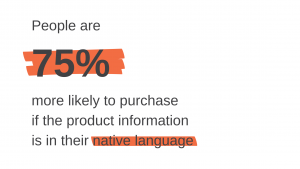
Have you heard the one about an American exchange student just settled in London who was asked by his roommate to bring home some chips? If you are familiar at all with the differences in American and British English, you can probably guess the outcome. The American student was gobsmacked when his roommate was disappointed by the bag of “crisps” he presented when he returned home.
This story is a perfect example of how words and phrases can differ in meaning depending on which location or culture they are used, or their “locale” – that’s localization. Even though the two students spoke a common language, the American could have used some pointers on how to localize his English for the UK to help him avoid this situation.
What is Localization and How Does it Differ from Translation?
Localization is sometimes confused with translation, but these terms actually mean two different things. Translation is part of localization, though localization is more comprehensive.
Translation involves converting a message from one language into another so that the meaning is the same. Translation includes grammar and spelling differences which can differ by the geographical location.
Localization is a more involved process that takes cultural, linguistic, and non-textual components into consideration when adapting a message, product, or service for another country or locale. A locale is a combination of a language and the physical place where it is spoken.
Localization is about much more than rewriting text into a different language, because it focuses on adapting your complete message to a specific audience and location. It addresses other aspects such as adapting graphics, using appropriate date and time formats, and adopting cultural references, among many other details.

Why is Localization Important?
In basic terms, localization is important because it makes your message better understood and more appealing to your intended audience. For example, Spanish is spoken in many countries, but localized content for Mexico would be different from localized content for Cuba or Spain. Just like in our opening story, miscommunication can happen when you use the wrong version of a term or saying for the location you are in. These language differences can make a big impact on the acceptance of your message. In some cases, it can impact safety.
Localizing content can help an organization expand its reach to a new audience, build loyalty among existing customers, and increase sales. Localization makes a product or service and the content surrounding it more engaging, which results in a higher return on your investment. It also allows an organization to communicate better and build loyalty among your geographically dispersed workforce or domestic employees who are more comfortable communicating in another language.
According to a 2014 Common Sense Advisory report, 75 percent of consumers said they were more likely to purchase goods and services if the corresponding product information is in their native language. And in another survey, half of senior executives said they believed localization leads to profitability and growth.
What Needs to be Localized?
There are many pieces of your communication that need to be localized beyond just using local terminology or words. Some of these include:
- Colors – They can have various meanings, depending on the target audience. In some countries, red expresses danger, white is associated with death, and orange expresses mourning and loss.
- Layout & Formatting – Some languages need more space than others to express the same concepts. Translation from English into other languages, for example, can result in the text taking up 30% to 100% more space. Elements such as dates, addresses, and phone numbers also need to be formatted to match your audience’s expectations.
- Visual Aides – Adapting photos and other visual aides to local cultures is a must-do.
- Units of Measurement – Most countries use the metric system, so converting units of measurements will be necessary to make content easy to follow for each specific locale.
- Currencies – Prices and monetary amounts may need to be converted from your base currency. Make it easy for potential buyers to make buying decisions and for business contacts negotiating contracts or navigating employment terms.
- Contracts, HR Documentation, Training Materials – When doing business or managing a workforce in foreign countries, you need to comply with local regulations and conventions to avoid legal implications or productivity issues.
- Content – Certain subjects may be taboo or handled very differently in another locale. Other expressions such as local idioms and cultural references also need to be localized to make sense for your target audience.
What Should You Look for When Choosing a Localization Service?
Localizing your translation project might sound intimidating, but it doesn’t have to be. SpokenHere’s full-service language services team is experienced in producing high-quality, localized projects on time and on budget. SpokenHere has the expertise and technology to handle any type or size of localization project, from websites, to employee documentation, to technical documentation, multimedia, voiceovers, training and eLearning, and marketing materials. Our localization services can help you expand your reach and make your customers and employees feel more at home.